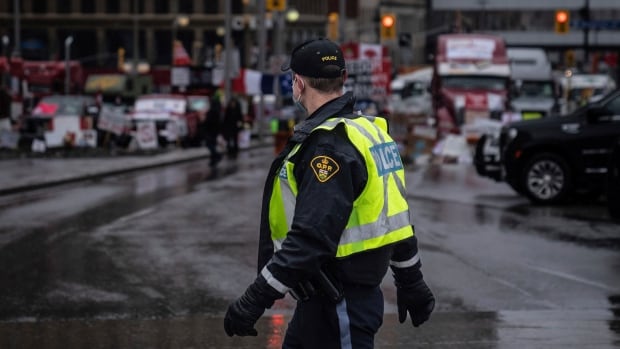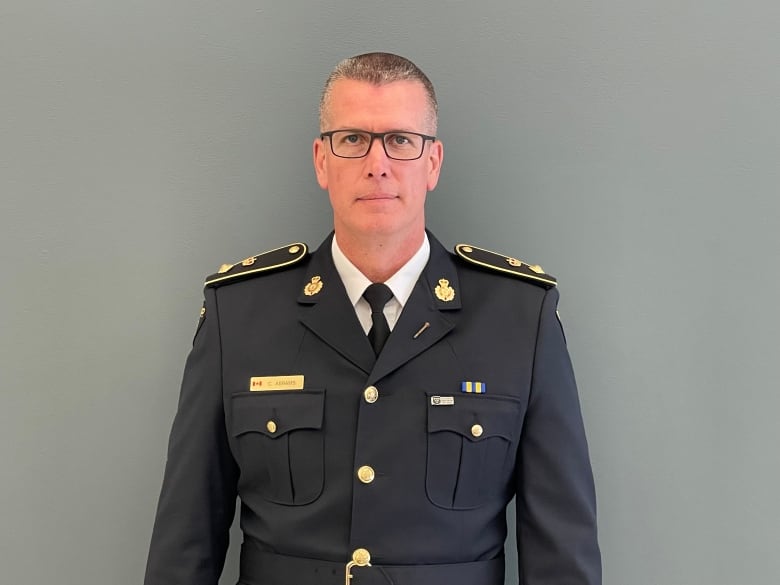
An OPP operations commander says there was dysfunction within the Ottawa Police Service (OPS) as early as the first weekend of the convoy protests — and persistent concerns that OPP members offered to Ottawa were not being properly used as the crisis continued.
Supt. Craig Abrams of the Ontario Provincial Police (OPP) also told an ongoing public inquiry that the decision by Ottawa police to shut down Highway 417 on-ramps into the city one week into the occupation came out of the blue and with no notice to the OPP, which has jurisdiction over the highway.
“We couldn’t read their minds as to what their plan was because there was no plan,” Abrams testified Thursday to the Public Order Emergency Commission.
The commission is studying whether the federal government’s decision to invoke the Emergencies Act to move the protesters was justified.
But it’s also offering the public a rare window into how different levels of government and police worked together — or didn’t — leading to the crackdown on protesters more than three weeks into the occupation.
From Jan. 28 to Feb. 19, protesters in downtown Ottawa rallied against pandemic restrictions and government leadership by blocking neighbourhood access and main arteries around Parliament Hill and clogging downtown streets with trucks and other vehicles.
Abrams said the OPP first became involved on the ground when convoy vehicles rolled through communities under OPP jurisdiction like Arnprior and Casselman, Ont.
“We did have situations where there was a tension at some restaurants where convoy participants [were] maybe not complying with the mask mandates,” he said.
Yelling at Ottawa planning centre
On Jan. 29 — the first Saturday of the occupation — Abrams got a concerning report from an OPP critical incident commander embedded in Ottawa at the National Capital Region Command Centre (NCRCC), which pooled municipal, provincial and federal resources, he said.
“She indicated that she was experiencing dysfunction within the NCRCC, specifically OPS commanders. [One] was yelling profanities not only at her, we also had a staff sergeant there. And they were also yelling profanities at each other.
“They had clearly, it seemed to her, lost control. They had calls for service they were not able to get to because all their members were tied up downtown.”
Thursday’s first witness, Patricia Ferguson, acting deputy chief of the Ottawa Police Service, addressed the tensions felt during the protests.
“I think one of the things we could have done better is listen[ed] to each other and [communicated] better and [been] more cohesive as a command team,” Ferguson said.
“I think, in moments of stress and crisis, people are not their best selves.”
On that first weekend, Abrams reached out to Ottawa police and offered 10 officers to help with traffic management — but officers sat around waiting for orders and were ultimately pulled back, he said.
Subsequent requests from Ottawa police for more OPP officers were vague in terms of what the officers were needed for, Abrams said. That concern was echoed by previous inquiry witnesses in regards to the requested surge in resources Ottawa police made for its final plan to eject the protesters.
“To ask for all these numbers without a plan and explanation of what they’ll be used for, seemed odd to me,” Abrams said.
‘We’re not giving them one inch’
Abrams said Ottawa police did not make good use of the experienced OPP negotiators, or “police liaison” team members, meant to form relationships with convoy members with the ultimate hope of drawing concessions from them.
Things came to a head over a Feb. 6 seizure of gasoline at a Coventry Road parking lot where protest participants stayed overnight and stockpiled fuel and other supplies.
Abrams said the seizure happened without any heads-up to police liaison members, who felt betrayed and who the inquest previously heard had made inroads with convoy members.
“The result, of course, was breakdown in the trust between the police liaison team and the protesters,” he said.

The inquiry has heard that the collapse in negotiation with protesters is what prompted the police to ask the City of Ottawa and ultimately the office of Mayor Jim Watson to try to connect with convoy members.
Ferguson said there was a rift within Ottawa police, with her and other members leaning toward negotiation efforts and former police chief Peter Sloly and others favouring an approach more focused on enforcing laws broken by protesters.
“One example was Porta Potties,” she said. “Organizers had asked for those to be delivered into the red zone and the direction was, ‘we’re not giving them one inch.'”
The enforcement camp ultimately won out, with over a dozen police agencies, including Ottawa police, the OPP and the RCMP, teaming up to push the protesters off Wellington Street and other downtown streets clogged with vehicles.
But it happened only after Sloly resigned his position and after securing the nearly 2,000 members needed to pull the plan off, in addition to the new powers granted under the Emergencies Act, such as the ability to force tow trucks to remove vehicles, the inquiry has heard.
Read a summary of Abrams’ pre-inquiry statement to the commission below: